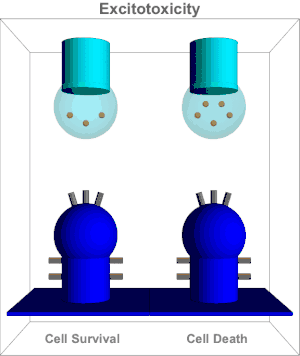Synaptopathy
A synaptopathy is a disease of the brain, spinal cord or peripheral nervous system relating to the dysfunction of synapses. This can arise as a result of a mutation in a gene encoding a synaptic protein such as an ion channel, neurotransmitter receptor, or a protein involved in neurotransmitter release. It can also arise as a result of an autoantibody targeting a synaptic protein. Synaptopathies caused by ion channel mutations are also known as synaptic channelopathies. An example is episodic ataxia. Myasthenia gravis is an example of an autoimmune synaptopathy. Some toxins also affect synaptic function. Tetanus toxin and botulinum toxin affect neurotransmitter release. Tetanus toxin can enter the body via a wound, and botulinum toxin can be ingested or administered therapeutically to alleviate dystonia or as cosmetic treatment.
| Synaptopathy | |
|---|---|
 | |
| A common cause of synaptopathy is glutamate excitotoxicity. As shown in the animation, the over-activation of NMDA receptors leads to an increase in free intracellular calcium, which produces oxygen free-radicals and eventually neuronal dysfunction.[1] |
Another example of synaptopathy occurs in the auditory system. This cochlear synaptopathy has been seen after prolonged noise exposure in both primate and non-primate models.[2][3] Two possible reasons for this neuronal death are both glutamate-mediated excitotoxicity in the postsynaptic terminal, and presynaptic ribbon damage which occurs by an unknown mechanism.[4]
Synaptopathies are attracting research interest because they provide an insight into fundamental mechanisms of synaptic transmission and because an improved understanding of disease mechanisms may lead to new treatments.
Some diseases of unknown etiology have been proposed to be synaptopathies. Examples include autism spectrum disorder[5] and schizophrenia.[6] Synaptic dysfunction can also occur in neurodegenerative disorders such as Alzheimer's.[7] Increasing knowledge of the genetic basis of these diseases has linked proteins to the function of the synapse. Age-related cochlear synaptic and neural degeneration has also been demonstrated in mice.[8]
Molecules such as FMRP1 act as translational repressor thus when ablated such as in FXS result in varying degrees of cellular and behavioural abnormalities. Additional molecules thought to be involved include SynGAP and SHANK1.[9]
References
- Mark, Leighton P; Prost, Robert W; Ulmer, John L; Smith, Michelle M; Daniels, David L; Strottmann, James M; Brown, W Douglas; Hacein-Bey, Lotfi (November 2001). "Pictorial Review of glutamate excitotoxicity: fundamental concepts for neuroimaging". American Journal of Neuroradiology. 22 (10): 1813–1824. PMID 11733308.
- Valero, MD; Burton, JA; Hauser, SN; Hackett, TA; Ramachandran, R; Liberman, MC (September 2017). "Noise-induced cochlear synaptopathy in rhesus monkeys (Macaca mulatta)". Hearing Research. 353: 213–223. doi:10.1016/j.heares.2017.07.003. PMC 5632522. PMID 28712672.
- Ruel, Jérôme; Wang, Jing; Rebillard, Guy; Eybalin, Michel; Lloyd, Ruth; Pujol, Rémy; Puel, Jean-Luc (May 2007). "Physiology, pharmacology and plasticity at the inner hair cell synaptic complex". Hearing Research. 227 (1–2): 19–27. doi:10.1016/j.heares.2006.08.017. PMID 17079104.
- Pujol, Rémy; Puel, Jean‐Luc (November 1999). "Excitotoxicity, synaptic repair, and functional recovery in the mammalian cochlea: a review of recent findings". Annals of the New York Academy of Sciences. 884 (1): 249–254. Bibcode:1999NYASA.884..249P. doi:10.1111/j.1749-6632.1999.tb08646.x. PMID 10842598.
- Wang, Xinxing; Kery, Rachel; Xiong, Qiaojie (June 2018). "Synaptopathology in autism spectrum disorders: Complex effects of synaptic genes on neural circuits". Progress in Neuro-Psychopharmacology and Biological Psychiatry. 84 (Pt B): 398–415. doi:10.1016/j.pnpbp.2017.09.026. ISSN 0278-5846. PMID 28986278.
- Hayashi-Takagi, Akiko (January 2017). "Synapse pathology and translational applications for schizophrenia". Neuroscience Research. 114: 3–8. doi:10.1016/j.neures.2016.09.001. PMID 27633835.
- Jha, Saurabh Kumar; Jha, Niraj Kumar; Kumar, Dhiraj; Sharma, Renu; Shrivastava, Abhishek; Ambasta, Rashmi K.; Kumar, Pravir (2017). "Stress-induced synaptic dysfunction and neurotransmitter release in Alzheimer's Disease: Can neurotransmitters and neuromodulators be potential therapeutic targets?". Journal of Alzheimer's Disease. 57 (4): 1017–1039. doi:10.3233/JAD-160623. PMID 27662312.
- Sergeyenko, Yevgeniya; Lall, Kumud; Liberman, M Charles; Kujawa, Sharon G (21 August 2013). "Age-related cochlear synaptopathy: an early-onset contributor to auditory functional decline". The Journal of Neuroscience. 33 (34): 13686–13694. doi:10.1523/JNEUROSCI.1783-13.2013. PMC 3755715. PMID 23966690.
- Brose, Nils; O'Connor, Vincent; Skehel, Paul (April 2010). "Synaptopathy: dysfunction of synaptic function?". Biochemical Society Transactions. 38 (2): 443–4. doi:10.1042/bst0380443. PMID 20298199.